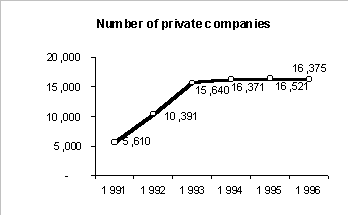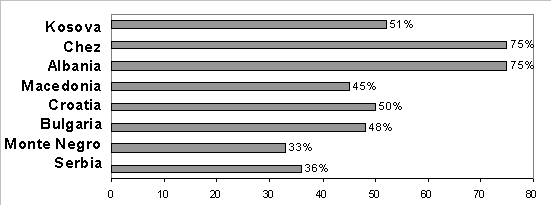
The organization of economic activities in Kosova before 1950 was based on family economies. Family business was concentrated in agriculture, cattle raising, and handicrafts in the conditions of a very primitive infrastructure. Natural products, traditional artisans and small manufacturers dominated in the production activities. The artisans and craftsmen were in service of such a structure of economy and were represented by traditional services, such as carpenters, leather craftsmen, blacksmiths’ etc. There existed a small group of merchants operating not farther than Tirana, Thessaloniki and Istanbul. This situation was characteristic for a typical agricultural country as it was Kosova in the eve of the Second World War. Technological progress initiated by Industrial Revolution had quite a small impact in economic life of Kosova.
Patriarchal organization of family economies in Kosova has a long tradition. It is strictly based on the definition of role, jobs, duties and responsibilities among family members with the domination of authority, words and orders of patter family heads. The role of men and women was also defined within family, especially in large families.
Despite many changes, in some farms still exist some traditional elements of family economies. After World War Two, according to state/social ownership and socialist concepts in economic system of former Yugoslavia, private economy was limited in agricultural family economies, small stores of greengrocers, small restaurants and handicrafts stores. The collectivization and nationalization of ownership in Yugoslavia was not complete as it was in other socialist countries. The role of private sector in former Yugoslavia was limited and inferior. The success in development was measured by the increasing of share of state/social sector in GDP. The overall social situation and the measures of economic policy destimulated the private sector. The only trends of modernization belong to individual agricultural family economies that supplied with the necessary equipment.
During the 80s, the so-called "small economy" became popular, whereby the private initiative would have the most significant role. Because of an overall institutional environment, the situation didn't change.
Taking into account the above-mentioned factors, the reason of decreasing private sector's share in GDP from about 40% that was in the beginning of the 50s, to about 20% in the end of 80s can be easily explained (SYK-89). The investments in private sector also decreased continually. Their proportion in total investments falls from 28% during the end of 50s to 16% in the beginning of 80s. The limitations of individual private initiative and small utilization of private sector potentials for productive and developing purposes can be illustrated by the structure of investments in private sector. The savings of population and their assets were engaged about 75-80% in housing construction, 12-15% in agriculture, about 3% in handicrafts and the rest in tourism and transport. Such a structure of investments expresses all defects of economic policy and of economic system in former Yugoslavia, a constitutive part of which was also Kosova.
In spite of all these obstacles, compared to other CEE countries, in former Yugoslavia there existed more autonomy for enterprises, decentralization and a higher influence of market, a certain level of liberalization of international economic relations and openness towards world market impulses. Elements of entrepreneurship were not totally out of the economic system of former Yugoslavia. That was a very important factor for a successful start in the development of private initiative and entrepreneurship in the beginning of 90s. But this comparative advantage has not been utilized due to the aggravation of political situation as described in the previous chapter.
4.1.2. THE DEVELOPMENT OF PRIVATE ECONOMY AFTER 1989
After 1989, in terms of reforms in former Yugoslavia, it became possible to found private enterprises, mixed enterprises, joint-stock companies with foreign partners. In that period, private economy in Kosova was represented, except family economies in agriculture and handicrafts, by 52 contracted enterprises, 20 handicraft cooperatives and 17 other cooperatives handycraft stores. In the beginning of 1990, the trend of establishing private enterprises was very impressive.

The data about private enterprises testify that the growth dynamics of the number of private enterprises was high in the period of 1991-1993, when the number of private enterprises increased for about 5.000 enterprises a year, whereas from 1994 this number was between 16.371-16.815. This can be taken as a sign of stagnation in development of private initiative, as ilustrated by the diagram.
An important element of private economy are the personal stores, which numbered 19.252 in Kosova in 1995, where the sphere of commerce (5.992 stores) and handicrafts (5.664) were dominating. To this belong also agricultural family economies (over 120.000).
Such a dynamics of private initiative development was manifested by a continually increasing of importance of private economy in overall economic activities of Kosova. This makes the role of private economy higher and higher as well as the increasing of awareness about its importance. Its share in GDP is illustrate in figure.

The share of private economy in GDP in the end of 1995 was around 50%. This is an evidently higher share compared to Montenegro (32.6%) and Serbia (36.5%), and similar to the share of the private sector in GDP of Macedonia, Georgia, Slovenia and Bulgaria. However, this proportion does not always have to express the power of private sector in an economy. Thus, for example, private sector has almost the same share in GDP of the Czech Republic and Albania, but private economy in these countries have qualitative differences between them.
The increasing of the proportion of private economy in GDP of Kosova is a consequence of some factors, such as:
Relying on "official" statistical data and analyses from polling of 300 private companies, it is possible to identify the key factors that stimulated and those that obstructed the development of private economy.
Stimulating factors are:
These problems can be mainly systematized in:
If we follow the fact that 300 polled enterprises are taken as a model of private economy, then derives that the qualifying structure of leadership is not so bad, as about 68% of them have high or superior education. Nearly 38% are economists and 25% engineers.
The concept of marketing also has not had any greater experience. There is still no professional market research. Only a small number of enterprises (8%) have created a regular practice in utilizing of promotion activities (advertisement and personal selling). According to the poll, the target market and the objective of activities and selling strategy is the market of Kosova (80%), and only 15% of total sales is realized in Serbia and Montenegro, whereas 5% in other countries.
Although from the poll and other analyses it can derive that the computerisation of business activities is being intensified (around 66% of enterprises have one or more PCs), yet this is not too much connected with the support of managerial activities. Thus, the application of computers is concentrated on financial evidences rather than in other activities. Possibilities for mutual communication and with foreign partners as well as the utilization of data base about stock markets through computer networks is being utilized very little (only 3% are connected to Internet).